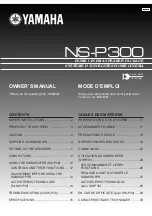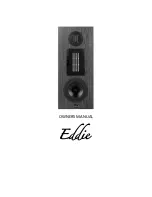
8
•
Connect the speakers to the speaker output terminals of
your amplifier with the provided speaker cords.
•
Connect the speakers making sure not to reverse the
polarity (+, –). Connect the (+) terminals on both the
amplifier and the speakers using one side of the cord.
Connect the (–) terminals on both components using the
other side of the cord. If one speaker is connected with
reversed polarity, the sound will be unnatural and lack bass.
•
For the main and effect speakers only
,
connect one
speaker to the left (marked L) terminals of your amplifier,
and another speaker to the right (marked R) terminals.
•
The subwoofer can be connected to either the speaker
output terminals or the line output (pin jack) terminals of the
amplifier. Choose one of the ways shown in this section
which is suitable for your audio system. Also, refer to the
owner’s manual for your component to be connected to this
unit.
CONNECTIONS
REAR
REAR
CENTER
CAUTION
SEE INSTRUCTION MANUAL FOR CORRECT SETTING.
MAIN
SPEAKERS
A
B
REAR
SINGLE
OUTPUT
TO SPEAKERS
INPUT1
FROM AMPLIFIER
OUTPUT
TO SPEAKERS
INPUT1
FROM AMPLIFIER
INPUT2
VOLUME
HIGH CUT
AUTO
STANDBY
STANDBY-RED
ON-GREEN
OFF
LOW
HIGH
0
10
OFF
POWER
ON
LOW
HIGH
Subwoofer
Effect speaker
Center speaker
Effect speaker
Right
Main speakers
Right
Left
Left
Amplifier
To AC outlet
Note
This diagram shows an example of connecting speakers to an amplifier which has two sets of main speaker output terminals. If you
select this connecting way, you must operate the amplifier so that both sets of main speaker output terminals output signals.
This speaker system can also be connected to the amplifier in other ways depending on the type of amplifier. Refer to pages 10 to
11 for details.
Never plug in the subwoofer and other audio/video components until all connections are completed.



































